Nauticam Wide Angle Underwater Optical Lenses
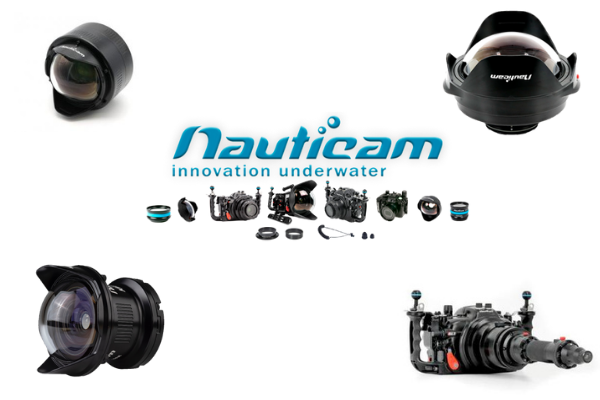
Nauticam is known for their sharp focus on underwater optics and their unique innovations in the field. For wide angle underwater photography and video, Nauticam's optics are the cutting edge. Recent inventions including the WACP-1, WACP-2, MWL, and EMWL have all introduced new artistic capacity for underwater creatives. Although these sounds like just an amalgamation of acroynms, we can assure you that each one of these tools in unique in its own respect. In this article, we're going to go over our four favorite wide angle lenses from Nauticam and how each one can be a useful tool for underwater photo and video.
These Nauticam Wide Angle Optical Innovations are AVAILABLE NOW at Bluewater Photo:
Nauticam Wide Angle Conversion Port - WACP-1
Nauticam Wide Angle Conversion Port - WACP-2
Nauticam Macro to Wide Angle Lens - MWL
Nauticam Exended Macro Wide-Angle Lens - EMWL
Who Should Buy These Lenses?
Each Nautiam wide angle lens or port is geared towards a very specific type of wide angle photographer. This is the kind of photographer each lens is meant for:
1. Nauticam WACP-1 - The Nauticam WACP is meant for photographers who want the highest quality rectilinear wide angle underwater photos. These photographers need sharp corners in their images, close focus, and a wide field of view without the distortion of a fisheye lens.
2. Nauticam WACP-2 - The Nauticam WACP-2 is meant for photographers that have all the requirements as the WACP-1 including sharp corners, close focus, and an extremely wide rectilinear field of view. The WACP-2 is also great for photographers that like to shoot over unders as it can focus above water. Finally, the WACP-2 is meant for photographers with a large budget - if you have a smaller budget we recommend the WACP-1.
3. Nauticam MWL - The Nauticam MWL is meant for photographers who want to shoot macro and wide angle photos on the same dive and don't mind compromising by shooting wide angle at f/16 or smaller.
4. Nauticam EMWL - The Nauticam EMWL is meant for creative photographers that don't want to follow the heard. A photographer using the EMWL needs to patient and willing to work to get results. But when you do get results they are an amazingly unique perspective. Finally, a photographer looking at the EMWL should have a fairly large budget.
Nauticam Wide Angle Conversion Port (WACP-1)
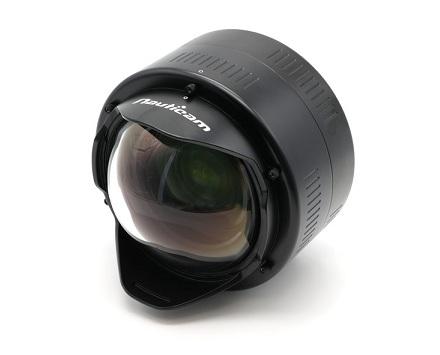
The Nauticam Wide Angle Conversion Port (WACP-1) is a revolutionary new port that is equipped with the best wide-angle, water-contact optics on the market. The WACP-1 is actually a hybrid between a lens and a dry port, and solves many of the problems that makes rectilinear wide angle photography difficult underwater.
While the WACP looks like a standard dome port, upon holding it, the weight alone proves it is much much more, and is really a lens disguised as a dry port. The WACP is a wide angle conversion port which unlike traditional ports or wet corrective wide-angle lenses, modifies a 28mm equivalent lens to an extremely sharp 130º fiels of view. The port attaches to Nauticam housings the same way other Nauticam ports do. The optical lenses behind the dome allow the camera to focus directly on the subject in the water rather than on the virtual image of the dome (as would be the case for a traditional dome port). This is water-contact optics and it's what makes the WACP special for underwater photographers and videographers. Here are some of the benefits of the WACP-1
- The WACP-1 increases the field of view for a 28mm full frame lens to an ultra-wide 130 degrees
- The center and corners of images taken with the WACP-1 are much sharper than images taken with traditional dome ports. This allows for underwater photographers and videographers to shoot at larger apertures and capture more light. It also allows for more creative photography with better bokeh at wider apertures
- The WACP-1 has full zoom through capability, which means that it can be paired with a lenses that have higher focal lengths than 28mm. Thus, it is compatible with popular rectilinear zoom lenses like 18-35mm lenses and 28-80mm lenses.
- A wide lens combined with WACP-1 has a very short minimum focusing distancing which means that you can focus on subject almost as close as the dome. With a traditional dome port, many popular rectilinear wide lenses need to be at least 10 - 11 inches from the subject to focus. This means that you can capture images will better color and extremely close-focus wide-angle compositions with the WACP-1
The WACP-1 is very similar to the incredibly sharp, quality Nikonos lenses of yesteryear, designed specifically, and only intended for underwater use. This port is specific to full frame cameras when using a 28mm lens. See below for a list of compatible lens options.
If you want an even wider option, designed for 14mm equivalent lenses, check out the WACP-2! It can produce a revolutionary 140 degree field of view with a 14mm equivalent lens - the widest rectilinear field of view on the market.
Underwater Buoyancy:
With all the professional optical elements crammed into one port, the WACP can be a little heavy topside. Thankfully, the WACP-1 package includes an aluminum float collar that makes the underwater buoyancy 0.71 lb (0.32 kg) negative.
Specifications:
- Depth Rating: 100m
- Weight on Land: 3.9 kg
- Weight Underwater: 0.32 kg
- Body Construction: Hard-anodized Aluminum Alloy
- Lens Construction: 6 Elements in 5 Groups
- Lens Coating: Anti-reflective on both sides
Compatible Lenses:
- Nikon AF-S 16-35mm f/4G EC VR
- Nikon AF-S 17-35mm f/2.8D EF-ED
- Nikon AF-S 18-55mm f/3.5-5.6G VR II
- Nikon AF-S 18-35mm f/3.5-4.5G ED
- Nikon AF-S Nikkor 28mm F/1.8G
- Nikon AF Nikkor 28mm f/2.8D
- Nikon AF Nikkor 28-70mm f/3.5-4.5D
- Canon EF 16-35mm f/2.8L III USM
- Canon EF 16-35mm f/4L IS USM
- Canon EF 17-40mm f/4L USM
- Cann EF-S 18-55mm f/3.5-5.6 IS STM
- Canon EF 28mm f/128 USM
- Canon EF 28mm f/2.8 IS USM
- Canon EF 28-70mm f/3.5-4.5II
- Canon EF 28-80mm f/3.5-4.5 II
- Canon EF 28-80mm f/3.5-5.6 V USM
- Canon EF 35mm f/2.0 IS USM
- Sigma 18-35mm f/1.8 DC HSM | A
- Sony FE 28-70mm f/3.5-5.6 OSS
Nauticam Wide Angle Conversion Port 2 (WACP-2)

The Nauticam WACP-2 is an upgrade to the WACP-1, capable of producing the widest rectilinear field of view on the market. Here are some of the benefits of the WACP-2:
- The WACP-2 increases the field of view of a 14mm full frame lens to an ultra-wide 140 degrees - the widest rectilinear field of view on the market. If you don't like the "fisheye" look - the WACP-2 gives you all the benefits of a fisheye lens without the distortion.
- The center and corners of images captured with the WACP-2 are much sharper than images taken with traditional dome ports. This allows you to shoot at larger apertures and capture more light underwater. It also produces a nicer bokeh underwater.
- The WACP-2 has full zoom through capability, which means that it can be used with lenses that have more zoom than 14 mm as well as zoom lenses like the Nikkor Z 14-30 or Canon 16-35.
- The WACP-2 creates a very short minimum focusing distance which means you can capture excellent close-focus wide-angle photos. With a traditional dome port, most rectilinear wide lenses would only be able to focus about 10-11 inches from the subject. The closer you can get to your subject underwater, the better your photos become!
- The WACP-2 is unique because it can focus on subjects above the water as well - which makes it perfect for over-under photos and video. The WACP-1 can't do this!
Yes, this port is pricey. But there truly isn't a better option out there if you are looking for the best rectilinear wide angle optics on the market.
WACP-2 vs WACP-1:
The Nauticam WACP-2 and WACP-1 are both engineering marvels in the same class of optics. Both produce amazing wide angle images with sharper corners, close focus, and a wider field of view. The main difference between the two ports is the type of lenses they are designed for. The WACP-1 was designed to work with 28mm equivalent lenses and produces a 130º field of view. The WACP-2 is designed to work with 14mm lenses to produce an unparalleled 140º field-of-view while maintaining full zoom-through optical capability. The field of view with the WACP-2 is unparalleled. For example, when a Nikkor Z 14-30mm f/4 S lens is combined with the WACP-2 you get an amazing field of view ranging from 81 degrees to 140 degrees
Finally, the design of this lens is elegant and a large improvement to the WACP-1. The new lens shade can be flipped underwater to prevent vignetting at wider focal lengths.
Underwater Buoyancy:
Amazing optics often require large lenses - and this rings true with the WACP-2. Thankfully, a float collar is included with the WACP-2 which makes it's underwater buoyancy 1.87 lb (0.85kg) negative.
Recommended Lenses
- Canon EF 16-35mm f/2.8L III USM
- Canon EF 16-35mm f/4L IS USM
- Canon RF 15-35mm f/2.8L IS USM
- Nikon AF-S 17-35mm f/2.8 IF ED
- Nikon AF-S NIKKOR 16-35mm f/4G ED VR
- Nikkor Z 14-30mm f/4 S
- Sony SEL1635GM FE 16-35mm F2.8 GM
- Sony SEL1635Z Vario-Tessar T* FE 16-35mm F4 ZA OSS
Nauticam Macro to Wide Angle Lens (MWL)
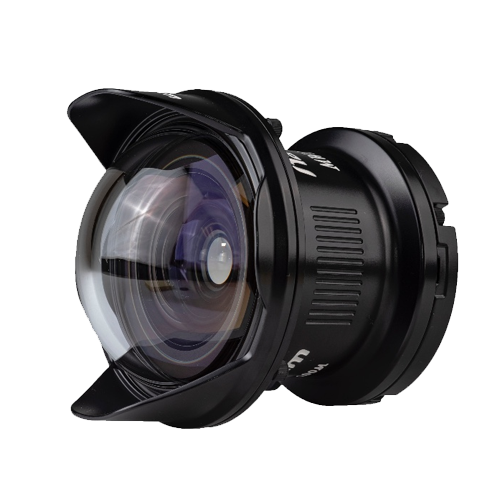
Aiming to allow DSLR and other interchangeable lens shooters the freedom of high quality wide angle and macro photography during the same dive, Nauticam created the Macro to Wide Angle Lens.
This lens is designed to work with a full frame 60mm macro lens (or equivalent APSC / Micro 4/3rds). It converts the narrow macro lens into an ultra-wide 150° angle of view.
About the MWL-1
The MWL-1 is constructed from precision ground optical glass with advanced anti-reflective coatings to eliminate glare and internal reflection. The lens is able to focus from the front element to infinity, offering the best results at aperture F16 or higher on a full frame camera. Photographers can capture unique close focus wide angle images of macro subjects by placing the subject extremely close to the front of the lens where the exaggerated perspective will make that subject pop out from an ordinary background.
Multiple Camera Compatibility
DSLR, Mirrorless, Compact. APS-C, MFT, 1" or Full Frame. The MWL-1 supports a wide variety of lenses and camera platforms. Field of View may vary with different lenses.
- Nikon AF-S DX Micro Nikkor 40mm F2.8
- Nikon AF-S Micro Nikkor 60mm F2.8
- Canon EF 40mm F2.8 STM
- Olympus M.Zuiko ED 30mm F3.5 Macro
- Panasonic Lumix G Macro 30mm F2.8
- Carl Zeiss Touit 2.8 / 50mm
- Compact Cameras (Sony RX100 III / IV / V / VI, Canon G7X I & II, Panasonic LX-10) when zoomed from 65mm.
Nauticam Extended Macro Wide Angle Lens (EMWL)
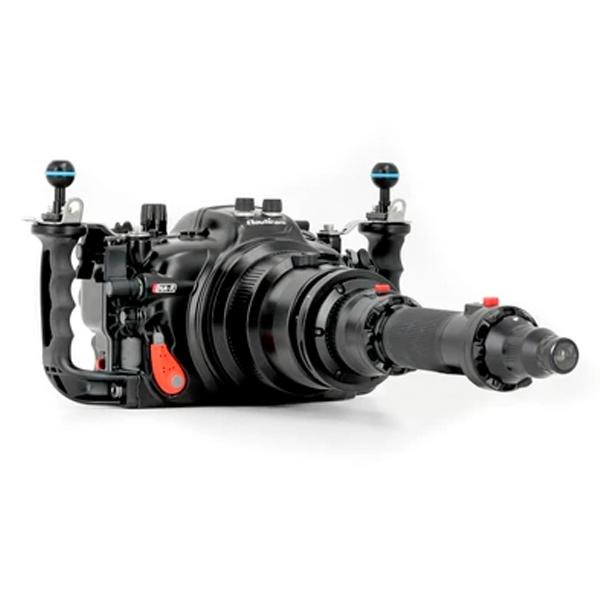
The Nauticam Extended Macro Wide-Angle Lens EMWL is a long bugeye wet lens that incorporates a wide angle field of view to macro images - truly a unique shooting style. It is built to work with popular macro lenses and shoots both stills and video. It is a wet lens so the lens can be attached and removed underwater. This makes it a very versatile lens and can even work with diopters such as the Nauticam SMC and CMC. The lens design is long and narrow which enables you to put the lens extremely close to your subject while keeping the bulk of the camera system at a distance.
The lens has a modular designed, and is comprised of 3 parts - a focusing unit, a relay module and an objective lens. It is optimized to work with different cameras and macro lenses.
Lens Components
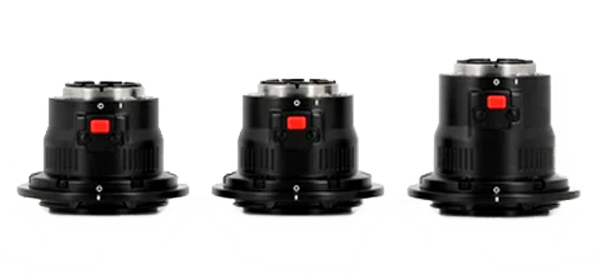 Focusing Unit
Focusing Unit
The focusing unit is the part that is connected closest to your port, and it is designed with 6 glass elements in 3 groups and attaches via the Bayonet Mount System. You can also have the option to add a manual focus gear. Lens adapters such as the Nikon FTZ, EF to EOS R or the Sigma MC-21 can also be used. There are three options to choose from Canon, Sony, and Nikon/Micro Four Thirds
Compatible Lenses:
| Canon | Sony | Nikon & Micro 4/3 | ||
| Canon EF 100mm f/2.8L Macro IS USM | Sony SEL90M28G FE 90mm F2.8 Macro G OSS | Nikon AF-S VR Micro Nikkor 105mm f/2.8G IF-ED | ||
| Canon EF-S 60mm f2.8 Macro USM for APS-C | Olympus M.Zuiko Digital ED 60mm f2.8 Macro |
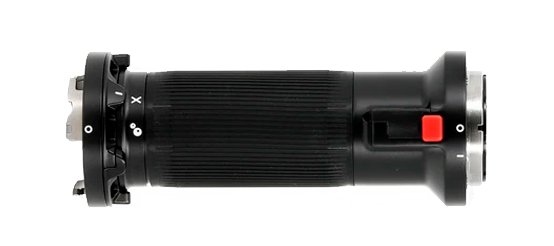
Relay Lens
The relay lens was designed with 14 glass elements in 10 groups. The EMWL Objective Lenses generates an inverted image, making it appear upside down. The Relay Lens corrects the inverted image and relays the image back to the focusing unit and sensor. It is 150mm in length and only 62mm at its widest point.
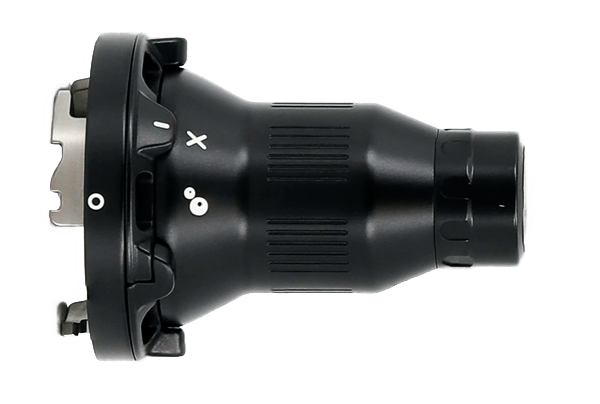
Objective Lens
The objective lens completes the EMWL and there are three different versions wihich produce varying degrees of angle-of-view - 130°, 100,° and 60° - in your image. You can swap the objective lenses underwater to change your field of view. Having multiple objective lenses gives you a larger creative pallet. It's possible to focus as close as the front element of the lens
130° - Widest of all objective lenses and is made up of 9 elements in 7 groups. It is perfect for larger macro subjects or any image where you want to see more of the background.
100° - The most versatile of the 3. It is the smallest in physical size, making it a good choice for timid subjects and tight spaces. It is designed with 9 elements in 6 groups.
60° - This lens has a narrower angle-of-view and the background elements look a little more compressed. There are three focusing ranges that can be set on the lens, 00-55mm, 55-25mm and 25-0mm. It is designed with 9 elements in 6 groups.
Mount
The EMWL uses the Nauticam Bayonet Mounting System II. You can easily attach or remove the lens underwater.
Recommended Accessories
- Nauticam Flip Holder for EMWL
- Nauticam Padded Travel Bag for EMWL (Focus Unit, Relay Lens and 3 Objective Lenses)
- Nauticam 130° Objective Lens Shade
- Nauticam 100° Objective Lens Shade - Nauticam M67 Mount to EMWL Focusing Unit
- Nauticam EMWL Bayonet Holder for 70mm Diameter Float Arms
- Nauticam EMWL Bayonet Holder for 90mm Diameter Float Arms
- Nauticam Strobe Mounting Brackets for EMWL Relay Lens
- Nauticam M67 to Bayonet Mount Converter
- Nauticam M77 to Bayonet Mount Converter
RECOMMENDED ARTICLES
SUPPORT THE UNDERWATER PHOTOGRAPHY GUIDE:
The Best Service & Prices on u/w Photo Gear
 Visit Bluewater Photo & Video for all your underwater photography and video gear. Click, or call the team at (310) 633-5052 for expert advice!
Visit Bluewater Photo & Video for all your underwater photography and video gear. Click, or call the team at (310) 633-5052 for expert advice!
The Best Pricing, Service & Expert Advice to Book your Dive Trips
 Bluewater Travel is your full-service scuba travel agency. Let our expert advisers plan and book your next dive vacation. Run by divers, for divers.
Bluewater Travel is your full-service scuba travel agency. Let our expert advisers plan and book your next dive vacation. Run by divers, for divers.































